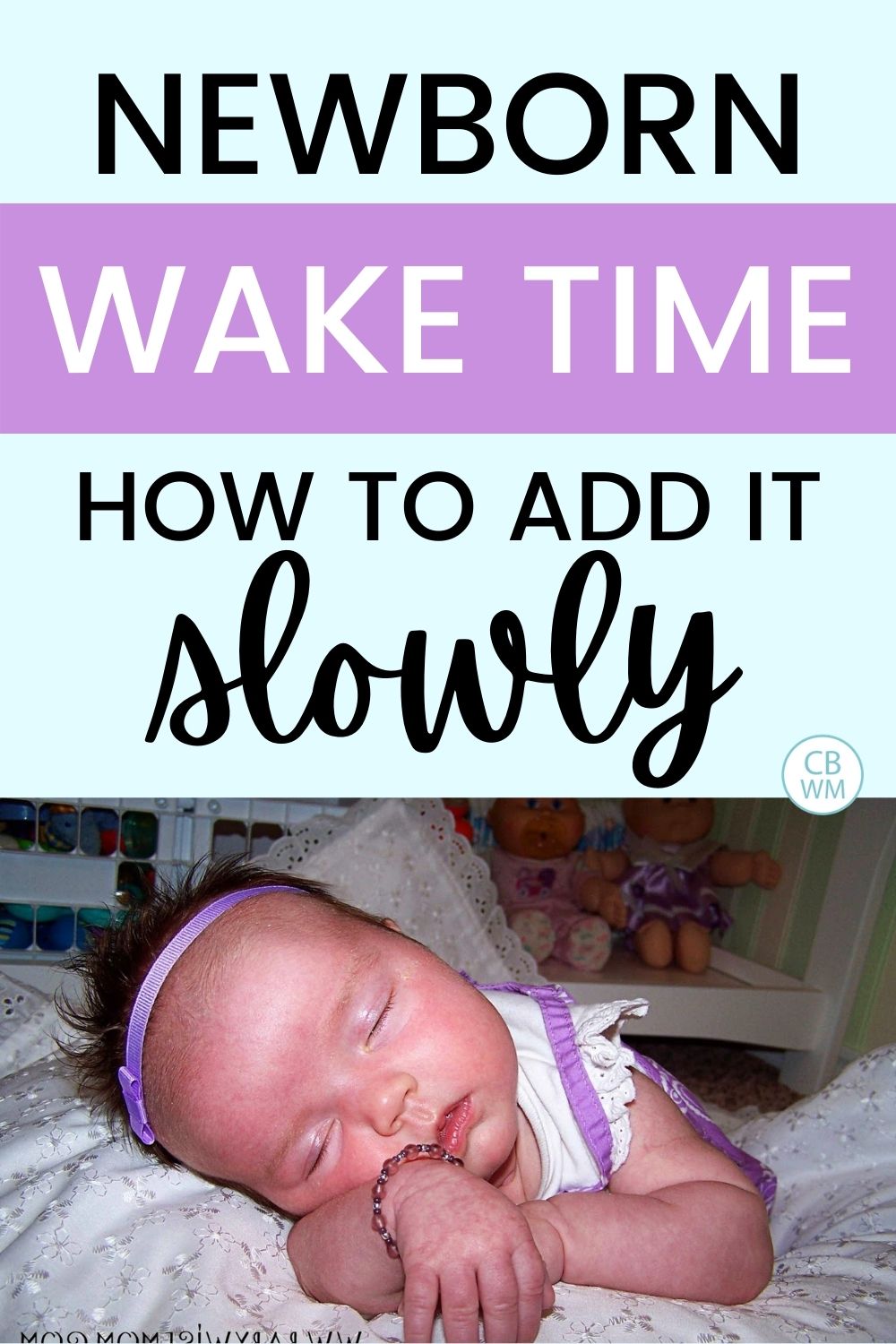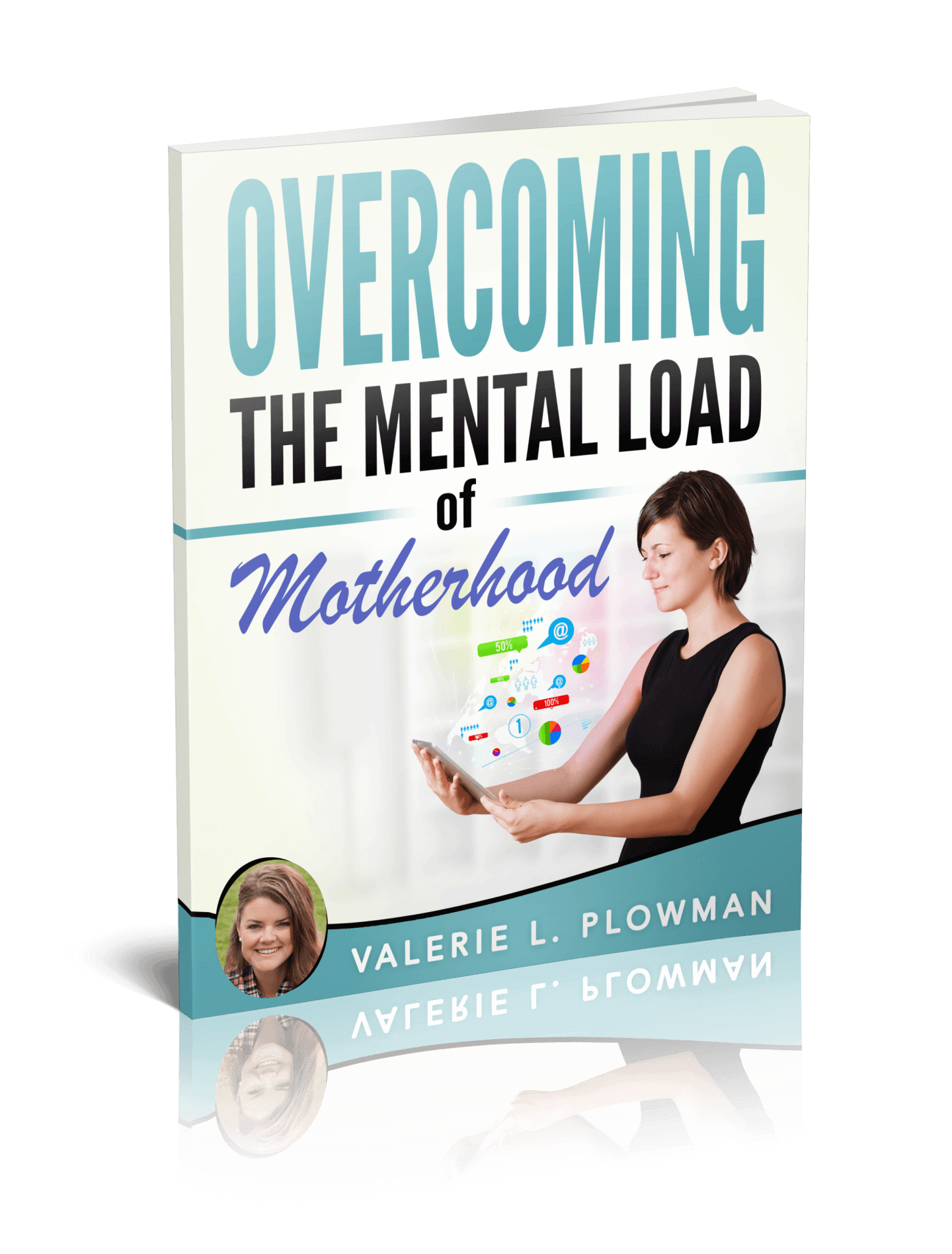How to add waketime to your newborns day when your newborn sleeps all day. Tips to get your newborn baby sleeping for naps and all night.

A key element to using an eat/wake/sleep cycle in your daily routine or schedule is the “wake” portion.
This means your little one is awake.
It sounds easy enough, but once you have a newborn here, you quickly realize it is easier said than done!
My strategies in this post really apply to the sleepy newborn. If your newborn is like my son was, he doesn’t want to sleep and you have no trouble keeping him awake unless it is time to nurse.
>>>Read: Keeping a Newborn Awake During Feedings
If your newborn is like my oldest daughter, however, you will put 110% of your effort into keeping her awake without any success.
You can hold her straight up and she continues to snooze.
She loves her sleep.
That is wonderful and all, but you know you need to add waketimes to the day to ensure she sleeps well at night, learns the difference between night and day, and gets some learning time in.
Here are my steps to adding waketime for your newborn.
First I will write out a sample feeding schedule so we can all be on the same page:
7:30–eat
10:30–eat
1:00–eat
4:00–eat
6:30–eat
9:30–eat, treat as dreamfeed. No waketime afterward.
11:00–possible feeding if baby will take it. Again, no waketime following this feeding. If you have another feeding at this time, you might feed at 9 PM instead of 9:30.
There are also night feeding(s) baby will wake for.

Post Contents
How to Keep a Newborn Awake
Here are six rules to follow when your newborn sleeps all day and you want to get some wake time happening. Follow these rules to rouse baby from her slumber. This will help you set up solid sleep habits.
Keep Baby Awake During Feedings
RULE 1: From day one, always work to keep baby awake during feeding times. See Keeping a Newborn Awake During Feedings for ideas on how to accomplish this.
Keeping sleepy babies awake for feedings is very hard, but worth it. It allows for full feedings. It also prevents napping during feeding time.
Some simple tips to help with this is to switch breasts if breastfeeding and changing baby’s diaper in the middle of the feed. If bottle feeding, you can switch positions to rouse baby. A cool washcloth can also be helpful.
What happens after the feeding is over will depend on where you are in your efforts.
WEEK ONE:
Your baby is 0-1 week old. During week one, don’t even worry about it. Let her sleep, and you in turn sleep as much as you can. Even my non-sleeper son was very sleepy this first week.
Babywise says during week one to simply focus on establishing nursing (if you bottlefeed establish that). It also says to not even pay attention to the clock, so just take this week to focus on yourself getting all the rest you can.
Keep Waketime Lengths Correct
RULE 2: As you start to add waketimes to your day, be sure you are keeping waketimes to an appropriate length.
Remember that for a newborn, 30 minutes (including feeding time) might be all she can handle.
See this post for help in figuring out the optimal waketime length for your baby: Optimal Waketime Lengths
WEEK TWO:
During week two (your baby is between 1-2 weeks old), choose one cycle in the day to start to try to keep her awake.
Write down your desired schedule and sleep schedule and decide which time of day would be best for you to try to keep her awake.
Maybe it is in the evening when Daddy is home. Maybe it is the first waketime of the day. This is the first one I did. I assumed it would be the easiest one since she had been sleeping without any waketime all night long.
Think of an activity that is likely to keep her awake. For me, this was a bath (or sponge bath and washing of hair before the umbilical cord fell off) in the morning.
Remember, don’t keep her up too long. Start slowly. Take the entire week to get her to stay awake for this one waketime. You aren’t in a race. Take it at her pace.
Stay Diligent and Pay Attention to Baby
RULE 3: As you are training your baby to stay awake for a waketime, keep in mind that it will take effort on your part.
While she is adjusting, you likely can’t leave her to lay somewhere by herself–even at a toy gym. She will fall asleep.
Once she is used to staying awake for that period of time, you can change your activities so you aren’t her sole source of entertainment all day, but while she is learning, be wary of leaving her to her own devices.
>>>Read: My Sleep Hierarchy for Newborns
WEEK THREE: During week three (your baby is between 2-3 weeks old), choose another cycle in the day to add some waketime to.
You will now have two waketimes in the day where baby is actually awake.
Again, don’t keep her up too long and work up to it throughout the week.
The second waketime I added was after her 4 PM feeding. My husband got home close to the time she was done eating, and Brayden usually wasn’t up yet, so it was some good time for him and her to spend together.
Stagger Which Wake Times To Keep Baby Awake
RULE 4: As you add more waketimes to the day, try to stagger them.
For example, don’t start with the first two waketimes of the day.
Do a waketime you try to keep her awake for, then just let her sleep for the next one. Then a waketime you keep her awake, let her sleep, etc.
You can stagger them more than that if you want to (one in the morning and one in the evening).
She will be more successful at staying awake for a wake time if she is better rested.
WEEK FOUR:
Your baby is between 3-4 weeks old.
As in other weeks, add one waketime to your day, so you are now up to three.
At this point, some babies might be able to add two instead of just one. Many start to be more awake at this age, but some (including my oldest daughter) are still very sleepy.
This was the age my son started to reject the idea of sleeping in the day (remember we didn’t start Babywise until he was 9 weeks old).
The third waketime I added for my daughter was after the 10:30 AM feeding. We occasionally ran errands and/or had visitors after this feeding, so it was a convenient time to have her awake for a bit.

Adjust for Growth Spurts
RULE 5: Growth spurts can really throw things off. 4 weeks is a typical growth spurt age, so be on the lookout for it.
Your baby won’t nap as long, so waketimes will likely need to be shorter than usual.
Watch for the nap cues to get an idea of when nap should be (see Baby Sleep Cues and How to Get it Right for Your Baby).
Also, once the eating portion of the growth spurt is over, the sleeping portion begins. Your baby will be more tired and take longer naps.
>>>Read: Baby Growth Spurts: Everything You Need To Know
WEEK FIVE: Your baby is between 4-5 weeks old. The babies who did not become more alert in week four often do in week five.
Again, you add a waketime to your day, but if your baby is more alert, you might be able to add two.
You will be up to four if you are doing one per day, and five if you have done more than one during a week.
Kaitlyn was super sleepy, so we just added one wake time. We added the waketime following her 6:30 PM feeding. This was a time for the family to be together and also get ready for bed.
If your little one is too tired because of a growth spurt, you can not add a wake time window this week.
Go Faster or Slower Depending on Baby’s Needs
RULE 6: If you find your baby is really sleepy, you can prolong the addition of another wake time window after a feeding if needed.
Perhaps you will take two weeks to add one waketime to the day and go into 6-7 weeks old or even 7-8 weeks old. Maybe you will take a week and a half.
If your baby is very alert, you can add more than one waketime to the day, just be cautious to not add too many at one time.
These strategies are not set in stone. Adapt them as useful to your family. Each baby is a unique individual, so always do what is best for your individual baby.
WEEK SIX: Your baby is between 5-6 weeks old.
You can again add a waketime to the day if you are still working on it. This should complete your waketimes unless you are going at a slower pace.
Your baby’s optimal waketime lengths might be extending also, so be mindful of that. Also, 6 weeks is another growth spurt time.
The last waketime I added with Kaitlyn was after her 1:00 PM feeding. One reason for this is that for the first four weeks, I napped at this time since Brayden was also napping. Another is that it was her hardest time of day to stay awake.
So, with our sample schedule, here is when I added real wake time after each feeding:
7:30–eat–1 Week Old
10:30–eat–3 Weeks Old
1:00–eat–5 Weeks Old
4:00–eat–2 Weeks Old
6:30–eat–4 Weeks Old
9:30–eat, treat as dreamfeed. No waketime afterward.
11:00–possible feeding. Again, no waketime afterward.
Conclusion
You should now be done! If not, continue adding waketimes as needed.
Again, your baby might need to start slowly, but can add them quickly as she gets older. She might need to take things more slowly. Take things at her pace. Each baby is different.
Don’t feel stressed out to add all waketimes all at once. It will all come with time.
As a review, your rules to follow are:
- Keep Baby Awake During Feedings
- Keep Waketime Lengths Correct
- Stay Diligent and Pay Attention to Baby
- Stagger Which Wake Times To Keep Baby Awake
- Adjust for Growth Spurts
- Go Faster or Slower Depending on Baby’s Needs
Read more about what to expect with newborn sleep here: Newborn Sleep Patterns
Related Posts
- How Long Should a Newborn Feeding Last?
- Babywise Sample Schedules: The First Month
- Sample Babywise Schedules: The Second Month
- My Sleep Hierarchy For Newborns
This post originally appeared on this blog November 2008







